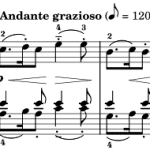Tempo, Pacing, and Personalization
CompetencyWorks Blog
Interested in this topic? Join us for the Pacing and Personalization webinar on February 12th, 3:30 ET. Register here.

There is no doubt we are creating new language to describe the next generation education system. It’s emerging quickly and is going to become one of the topics that I write about.
I stumbled upon the concept of tempo in Sal Khan’s book The One World Schoolroom. It’s a beautiful and magical word to describe the rhythm of a student’s learning and how it changes. I doubt we’ll end up using musical language to explain the tempo of student learning such as larghissimo , andante, presto, allegro and agitato (note how those last two both indicate emotion and tempo). I do think we will soon be creating language that helps us discern how a student is engaging in their studies:
- Slow pace with many distractions from the traumas in their life (remember how hard it was to work during 9/11? Imagine what it feels like to be a student trying to study in a school in lockdown or your mother ill with cancer
- Slow pace, challenged by the material and committed to fully mastering it.
- Teacher pace of moderate pace with deep dives to explore a topic
- Rapid pace in reviewing content they have covered before
- Rapid progress at level three, moving onto advanced material without exceeding expectations for proficiency
- Rapid pace constantly striving to exceed expectations
Or perhaps we will find an entirely different way of thinking about the tempo of student learning?
I saw a glimpse of how pacing is going to become a common way of monitoring effectiveness during my visit to Barack Obama Charter School (more to come about this and other school visits in California this week), I had the opportunity to look at how their information system, Educate, offers principals, district staff…and yes, even state officials, the opportunity to keep an eye on pacing.
Based on student learning progressions, their progress in demonstrating proficiency on competencies, the system visually showed how the school (or class or sub-group of students) was doing compared to a 1.0 rate of growth and a 1.5 rate of growth. We are definitely on our way to beginning to benchmark pacing across schools.
We still need to figure out what this means for the highly differentiated school in which some students, with proper scaffolding, are working on competencies across several levels whereas other students are simply working on the competencies and learning objectives at their level.
Perhaps we shall call that tempo eroico (heroic) for the courage and perseverance it takes to stay in school and tackle new topics without the foundational literacy and math skills.